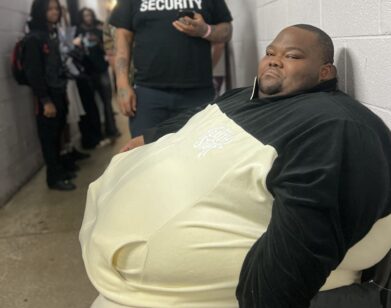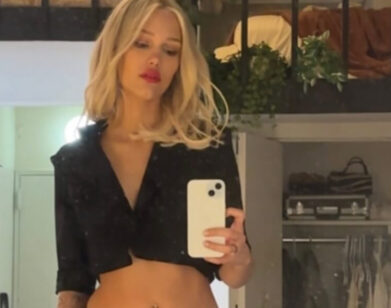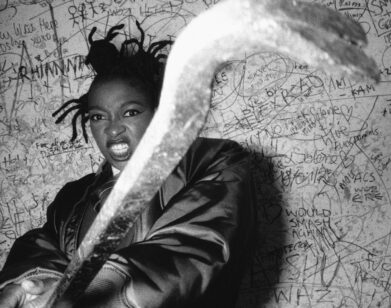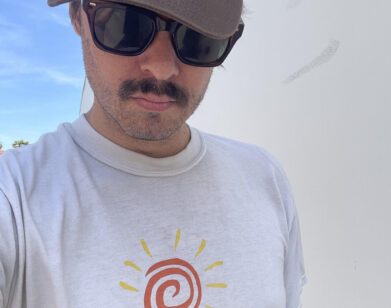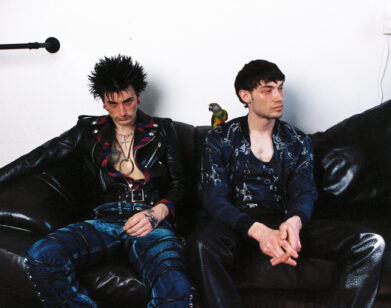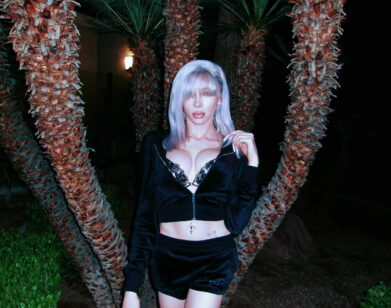Colour me Black
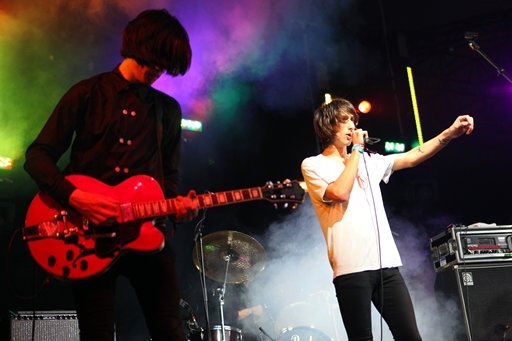
At Coachella this year: A better look for The Horrors. Photo by Zach Cordner/Retna.
Â
Three years ago, The Horrors made their debut amidst a bloody mess. With the bassline and hoarse vocals on their first single, “Sheena Is A Parasite,” the Southend-based band turned quite a few heads. But when Chris Cunningham got Samantha Morton to play a viscera-spewing succubus for the video, they also turned stomachs. Like many such pleasures, the clip was universally banned, and secured the Horrors’ reputations outcasts among their less visual peers. Their imageâ??Jack Skellington meets Edward Goreyâ??has been eyed suspiciously by those who find style and substance incompatible. And their musical agenda, a nightmarish marriage of menacing surf rock, psychobilly, and “zombie garage,” was equally puzzling. More indebted to the graveyard of Sixties obscurities than anything released on Rough Trade, debut album Strange House was a self-described “psychotic” retort to all the Eighties worship. It polarized skeptics, but delighted anyone who’d ever wondered how the Cramps would sound produced by Joe Meek. But even Horrors admirers had to ask: how long could this freakshow last?
The answer: a lot longer that you expected. On Primary Colours, their excellent second album, Faris Badwan and co. continue to churn out queasy psychedelia steeped in morbidity. But they’ve upgraded, trading in Farfisa organs for spectral synthesizers, their sensibilities more krautrock than frat rock this time around. “Sea Within A Sea,” an epic, eight-minute single that “says everything that needs to be said about who The Horrors are in 2009,” bassist/synth player Tom Cowan says. Indeed, a lot will be said about the Horrors this year. After playing two sold out New York shows opening for The Kills this weekend, they release Primary Colours today to whispers of “album of the year” contention. But Tom and bandmate Joshua Von Grimm are unshaken by the sudden adoration. They know they’ve made a great album. Now to let it find its audience…
COLLEEN NIKA: Primary Colours is getting amazing feedback. But I’ve actually heard that Faris has stopped reading the band’s press. What about the rest of you?
TOM COWAN: That’s only Farisâ??he always has to be contrary (LAUGHS). But, of course, we’re all really, really pleased with the reaction. Why wouldn’t we be?
CN: Does the positive reaction surprise you?
TC: No, not at all.
JOSHUA VON GRIMM: Last summer, when we started writing and recording the album, there was this brilliant, jubilant feeling in the air. We were very excited, and felt that what we were doing was very fresh and that people would have to take notice this time around. And now we’re seeing returns!
Â
CN: In many ways, Primary Colours is a complete reinvention. At what point did you decide to shift in an entirely different direction?
JVG: We’ve always wanted to move forward. And the shift forward was already beginning on our debut: If you listen to a song like “A Train Roars,” you can see we were already moving into very different territory from the earlier tracks. We’re very easily bored, so we knew we had to evolve. And Primary Colours took shape very organically.
CN: Why did you gravitate towards krautrock and shoegaze?
TC: It really comes down to what we were listening to during the past few years. I started listening to Can not all that long ago, for instance. But we weren’t listening to specific albums in order to analyze the guitars or the motorik beatsâ??those krautrock flourishes are there, but there are so many other elements at work, too. Overall, I’d say we are driven by the emotional range, rather than by certain styles, of music.
CN: Geoff Barrow of Portishead produced a lot of the album. Why did you decide to work with him?
JVG: We mutually arrived at the decision. Geoff invited us to play his All Tomorrow’s Parties festival, because he loved our first record. We played him the demos we’d been working on for the new album and he reacted very favorably, saying they were “brilliant” and that “you’re really onto something now.”
CN: I’m sure that felt good.
JVG: It did! And he said we needed a producer who wouldn’t interfere, who wouldn’t change or distill what we’d created.
CN: Did his previous production work influence the musical ideas on Primary Colours? I can see shades of Portishead’s Third throughout the album…
TC: To a point, but only as much as anything else. Portishead is a really amazing band that we respect. On Third, they did have that massive kraut thing going on, along with channeling John Barry and Silver Apples. It’s their interpretation of that era, and they wear it on their sleeve…
JVG: But we’d already recorded many ideas for the new album prior to meeting Geoff, so he didn’t really dictate the direction at all. Geoff is about preserving the integrity of those ideas.
CN: What did he teach you?
TC: He stopped us from taking things too far. You can get really lost in all the sounds and textures.
JVG: That’s the best thing about Geoff. He comes from a hip-hop backgroundâ??which is similar to a punk background, in terms of arranging elements to a song. He’d say, “You need four sounds at once.” But he’d take those sounds and make them sound really big.
CN: “Sea Within A Sea” is eight minutes long and has no chorus, and you chose it as your first single. I love that. Were you trying to be difficult?
TC: It says everything that needs to be said in the new album. And it says it without it having to be packaged into a three minute pop single, and without having to concern ourselves with how it would fare in the charts. We put it out there, and let people draw their own conclusions.
CN: How will you blend the new and old material on the road?
TC: We don’t. We’re only playing the new songs. Our earlier fans hopefully already saw us on the last tour. We tried to mix the two records live, and it didn’t really work. Performing the new material alone feels more appropriate; it makes for a more complete show.
JVG: We take great faith in the fact that people were willing to be challenged by unfamiliar material before, when we first toured. We want each tour to feel new. On the third album, we’ll start fresh again. If we play those old songs now, we’d probably be doing them a disservice.
CN: Speaking of older material, do you have any thoughts on Strange House now? In retrospect, how do you think it holds up?
TC: I think it holds up really fucking well.
JVG: It’s great.
CN: Did you feel fairly treated by the press when you first started out? I remember all the style vs substance debates.
TC: There were a lot of crossed wires between us, Universal, and the press. It’s like Chinese whispers: the message really gets lost in translation. What we were doingâ??what we thought we were doingâ??was being sold as something different.
CN: What were you being sold as?
TC: A product. And one they didn’t even understand. I think people saw the makeup and hair and decided we were costumey. That’s how the label marketed us, and since we fit in with no particular scene, that’s how certain members of the press interpreted the Horrors.
CN: A ghoulish gimmick?
TC & JVG: Yeah.
CN: A lot of the Goth bands you like were critically derided, or considered too theatrical to take seriously, at first….
TC: I have an issue of NME from 1978 with the Cramps on the cover. And in that same issue, they gave the band a terrible live review, and also slated Cabaret Voltaire and Throbbing Gristle, both bands that went on to become completely influential.
CN: Your initial funereal band image reminded me of Edward Gorey, which I liked. But have you purposely toned down your image this era?
TC:Â I think that between 18 and 21 you mature, simple as that.
JVG: We weren’t really that concerned with a particular style or image to begin with. That’s just how we happened to dress at the time. Actually, I didn’t learn who Edward Gorey was until much later (LAUGHS).
The Horrors’ Primary Colours hits stores today. They are currently opening for the Kills on a North American tour, before embarking overseas for European dates.

